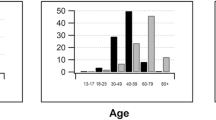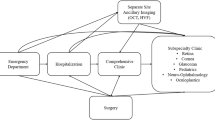Abstract
Background
Health-related social needs (HRSN), or unmet conditions that are important to maintain health (such as finances and transportation), contribute to vision health disparities. The purpose of this study is to identify the unmet HRSN of ophthalmology clinic patients.
Methods
This retrospective, cross-sectional study examined HRSN survey results from adult patients who checked in for a clinic visit at a tertiary academic eye centre from April 28, 2022, to March 31, 2023. Demographics and visual acuity were extracted from the electronic health record, and their reported HRSNs were evaluated using binary logistic regression.
Results
Of 1413 patients who completed the survey, 194 (13.7%) screened positive for at least one HRSN. The most frequently reported need was food insecurity (99/1303, 7.6%), followed by transportation (68/1340, 5.1%), housing instability (63/1305, 4.8%), financial insecurity (46/1293, 3.6%), and homelessness (10/1330, 0.8%). Patients with at least one reported HRSN were more likely to be Black compared to White (OR 4.03, 95% CI: 2.71–5.96), female compared to male (OR 1.88, 95% CI: 1.34–2.62), and younger than 65 years of age compared to 65 to 75 years (OR 2.35, 95% CI: 1.68–3.37) or older than 75 years (OR 4.62, 95% CI: 2.54–8.16). Presence of at least one HRSN was associated with visual impairment, with greater odds of best-corrected visual acuity worse than 20/40 in the group with HRSN compared to without HRSN (OR 1.55, 95% CI: 1.09–2.19).
Conclusion
Integrating a screening questionnaire in ophthalmology clinics can uncover unaddressed HRSN, enabling resource allocation to mitigate vision health disparities.
This is a preview of subscription content, access via your institution
Access options
Subscribe to this journal
Receive 18 print issues and online access
$259.00 per year
only $14.39 per issue
Buy this article
- Purchase on SpringerLink
- Instant access to full article PDF
Prices may be subject to local taxes which are calculated during checkout

Similar content being viewed by others
Data availability
The datasets used and analysed during the current study are available from the corresponding author upon reasonable request.
Notes
Consistent with most Likert-scale based questions, there was not a free-text option to capture patient-specific subjective interpretations of Likert scale options (e.g., “sometimes true” for food insecurity is subject to each participant’s individual interpretation). To account for this limitation, we also conducted a sensitivity analysis in which food insecurity was defined more strictly by the top-box selection of “often true” (rather than “often true” or “sometimes true”). The conclusions regarding associations between demographic characteristics and food insecurity were not substantially different when only the “often true” responses were considered a positive screen (n = 79 for “often true” compared to n = 99 for “often true” or “sometimes true”).
References
Elam AR, Tseng VL, Rodriguez TM, Mike EV, Warren AK, Coleman AL. American Academy of Ophthalmology Taskforce on Disparities in Eye Care. Disparities in vision health and eye care. Ophthalmology. 2022;129:e89–e113.
Williams AM, Sahel JA. Addressing social determinants of vision health. Ophthalmol Ther. 2022;11:1371–82.
Social Determinants of Health - Healthy People. 2030 | Health.gov. https://health.gov/healthypeople/priority-areas/social-determinants-health. Accessed 10 January 2024.
Solomon SD, Shoge RY, Ervin AM, Contreras M, Harewood J, Aguwa UT, et al. Improving access to eye care: a systematic review of the literature. Ophthalmology. 2022;129:e114–e126.
Green K, Zook M. When talking about social determinants, precision matters. Health Affairs Forefront. https://doi.org/10.1377/forefront.20191025.776011. Accessed 10 January 2024.
Kolli A, Mozaffarian RS, Kenney EL. Food insecurity and vision impairment among adults age 50 and older in the United States. Am J Ophthalmol. 2022;236:69–78.
Besagar S, Yonekawa Y, Sridhar J, Finn A, Padovani-Claudio DA, Sternberg P Jr, et al. Association of socioeconomic, demographic, and health care access disparities with severe visual impairment in the US. JAMA Ophthalmol. 2022;140:1219–26.
Johnson-Griggs MA, Hicks PM, Lu MC, Sherman E, Niziol LM, Elam AR, et al. Relationship between unstable housing, food insecurity, and vision status in the MI-SIGHT community eye disease screening program. Ophthalmology. 2024;131:140–9.
Kim AB, Cheng BT, Tanna AP. Delayed medical care due to lack of transportation among US adults with glaucoma. Ophthalmol Glaucoma. 2023;6:439–41.
Elam AR, Nwanyanwu KH, Scott AW. Elevating social determinants of health and community engagement in eye care-the time is now. JAMA Ophthalmol. 2022;140:453–4.
Zarnegar A, Cassidy J, Stone A, McGinnis-Thomas D, Wasser LM, Sahel JA, et al. Effect of a patient navigator program to address barriers to eye care at an academic ophthalmology practice. J Acad Ophthalmol. 2023;15:e106–e111.
Buitron de la Vega P, Losi S, Sprague Martinez L, Bovell-Ammon A, Garg A, James T, et al. Implementing an EHR-based screening and referral system to address social determinants of health in primary care. Med Care. 2019;57:S133–9.
Loo S, Anderson E, Lin JG, Smith P, Murray GF, Hong H, et al. Evaluating a social risk screening and referral program in an urban safety-net hospital emergency department. J Am Coll Emerg Physicians Open. 2023;4:e12883.
Rogers AJ, Hamity C, Sharp AL, Jackson AH, Schickedanz AB. Patients’ attitudes and perceptions regarding social needs screening and navigation: multi-site survey in a large integrated health system. J Gen Intern Med. 2020;35:1389–95.
Albert SM, McCracken P, Bui T, Hanmer J, Fischer GS, Hariharan J, et al. Do patients want clinicians to ask about social needs and include this information in their medical record? BMC Health Serv Res. 2022;22:1275.
Nelson CC. Using a social determinants of health summary measure to predict general health status in the BRFSS. Am J Health Promot. 2022;36:301–4.
Visweswaran S, McLay B, Cappella N, Morris M, Milnes JT, Reis SE, et al. An atomic approach to the design and implementation of a research data warehouse. J Am Med Inform Assoc. 2022;29:601–8.
Adepoju OE, Liaw W, Patel NC, Rastegar J, Ruble M, Franklin S, et al. Assessment of unmet health-related social needs among patients with mental illness enrolled in Medicare Advantage. JAMA Netw Open. 2022;5:e2239855.
Goyal A, Richards C, Patel V, Syeda S, Guest JM, Freedman RL, et al. The Vision Detroit Project: visual burden, barriers, and access to eye care in an urban setting. Ophthalmic Epidemiol. 2022;29:13–24.
Scanzera AC, Kravets S, Hallak JA, Musick H, Krishnan JA, Chan RVP, et al. Evaluating the relationship between neighborhood-level social vulnerability and patient adherence to ophthalmology appointments. Ophthalmic Epidemiol. 2024;31:11–20.
Chaudhury AS, Ige M, Marwah S, Zhou X, Andrews CA, Kanwar K, et al. Race, social determinants of health, and the quality of diabetic eye care. JAMA Ophthalmol. 2024;142:961–70.
Chan AX, Radha Saseendrakumar B, Ozzello DJ, Ting M, Yoon JS, Liu CY, et al. Social determinants associated with loss of an eye in the United States using the All of Us nationwide database. Orbit 2022;41:739–44.
Halawa OA, Kolli A, Oh G, Mitchell WG, Glynn RJ, Kim DH, et al. Racial and socioeconomic differences in eye care utilization among Medicare beneficiaries with glaucoma. Ophthalmology. 2022;129:397–405.
Muñoz B, West SK, Rubin GS, Schein OD, Quigley HA, Bressler SB, et al. Causes of blindness and visual impairment in a population of older Americans: The Salisbury Eye Evaluation Study. Arch Ophthalmol. 2000;118:819–25.
Wolfe MK, McDonald NC, Holmes GM. Transportation barriers to health care in the United States: findings from the National Health Interview Survey, 1997-2017. Am J Public Health. 2020;110:815–22.
Myers AM, Painter MA. Food insecurity in the United States of America: an examination of race/ethnicity and nativity. Food Secur. 2017;9:1419–32.
Madden JM, Bayapureddy S, Briesacher BA, Zhang F, Ross-Degnan D, Soumerai SB, et al. Affordability of medical care among Medicare enrollees. JAMA Health Forum. 2021;2:e214104.
Zetterberg M. Age-related eye disease and gender. Maturitas 2016;83:19–26.
Anjum KM, Qureshi MB, Khan MA, Jan N, Ali A, Ahmad K, et al. Cataract blindness and visual outcome of cataract surgery in a tribal area in Pakistan. Br J Ophthalmol. 2006;90:135–8.
Kumar P, Brinson J, Wang J, Samuel L, Swenor BK, Scott AW, et al. Self-reported vision impairment and food insecurity in the US: National Health Interview Survey, 2011-2018. Ophthalmic Epidemiol. 2023;30:468–76.
Jung NM, de Bairros FS, Pattussi MP, Pauli S, Neutzling MB. Gender differences in the prevalence of household food insecurity: a systematic review and meta-analysis. Public Health Nutr. 2017;20:902–16.
Atta S, Zaheer HA, Clinger O, Liu PJ, Waxman EL, McGinnis-Thomas D, et al. Characteristics associated with barriers to eye care: a cross-sectional survey at a free vision screening event. Ophthalmic Res. 2023;66:170–8.
Hom GL, Cwalina TB, Jella TK, Singh RP. Assessing financial insecurity among common eye conditions: a 2016-2017 National Health Survey study. Eye. 2022;36:2044–51.
Pera MF, Cain MM, Emerick A, Katz S, Hirsch NA, Sherman BW, et al. Social determinants of health challenges are prevalent among commercially insured populations. J Prim Care Community Health. 2021;12:21501327211025162.
Funk IT, Strelow BA, Klifto MR, Knight OJ, Van Buren E, Lin FC, et al. The relationship of travel distance to postoperative follow-up care on glaucoma surgery outcomes. J Glaucoma. 2020;29:1056–64.
Lee DJ, Kumar N, Feuer WJ, Chou CF, Rosa PR, Schiffman JC, et al. Dilated eye examination screening guideline compliance among patients with diabetes without a diabetic retinopathy diagnosis: the role of geographic access. BMJ Open Diabetes Res Care. 2014;2:e000031.
Leiby BE, Hegarty SE, Zhan T, Myers JS, Katz LJ, Haller JA, et al. A randomized trial to improve adherence to follow-up eye examinations among people with glaucoma. Prev Chronic Dis. 2021;18:E52.
Clarke P, Khan AM, Kamdar N, Seiler K, Latham-Mintus K, Peterson MD, et al. Risk of type 2 diabetes mellitus among adults aging with vision impairment: the role of the neighborhood environment. Disabil Health J 2023;16:101371.
Lam PY, Chow SC, Lai JSM, Choy BNK. A review on the use of telemedicine in glaucoma and possible roles in COVID-19 outbreak. Surv Ophthalmol. 2021;66:999–1008.
Claessens JLJ, Geuvers JR, Imhof SM, Wisse RPL. Digital tools for the self-assessment of visual acuity: a systematic review. Ophthalmol Ther. 2021;10:715–30.
Wasser LM, Bear TM, Sommers M, Cassidy J, Muir KW, Williams AM. Barriers to care among glaucoma patients with a missed appointment and interest in a navigator program. J Glaucoma. 2024;33:297–302.
Groves RM, Peytcheva E. The impact of nonresponse rates on nonresponse bias: a meta-analysis. Public Opin Q. 2008;72:167–89.
Funding
This work was supported by the National Institutes of Health (NIH) through Grant UL1 TR001857, NIH CORE Grant P30 EY08098, the Henry L. Hillman Foundation, the Eye and Ear Foundation of Pittsburgh, and by an unrestricted grant from Research to Prevent Blindness to the Department of Ophthalmology at the University of Pittsburgh. The funding organizations had no role in the design or conduct of this research.
Author information
Authors and Affiliations
Contributions
All authors attest that they meet the current ICMJE criteria for Authorship. NM wrote the original draft of the manuscript; JC, LMW, and PJL collected and analysed data; AMW provided supervision and edited the manuscript.
Corresponding author
Ethics declarations
Competing interests
AMW receives funding from the National Science Foundation, Research to Prevent Blindness, the Chandler-Grant Glaucoma Society, and the American Glaucoma Society. No other contributing authors have competing interests.
Ethics approval
This study was deemed exempt from review by University of Pittsburgh Institutional Review Board. Additionally, this study adheres to the ethical principles for human research established by the Helsinki Declaration and the Belmont Report.
Additional information
Publisher’s note Springer Nature remains neutral with regard to jurisdictional claims in published maps and institutional affiliations.
Rights and permissions
Springer Nature or its licensor (e.g. a society or other partner) holds exclusive rights to this article under a publishing agreement with the author(s) or other rightsholder(s); author self-archiving of the accepted manuscript version of this article is solely governed by the terms of such publishing agreement and applicable law.
About this article
Cite this article
Mayer, N., Cassidy, J., Wasser, L.M. et al. Seeing the unseen: uncovering health-related social needs through universal screening at an academic ophthalmology practice. Eye 39, 1501–1507 (2025). https://doi.org/10.1038/s41433-025-03690-9
Received:
Revised:
Accepted:
Published:
Issue date:
DOI: https://doi.org/10.1038/s41433-025-03690-9



